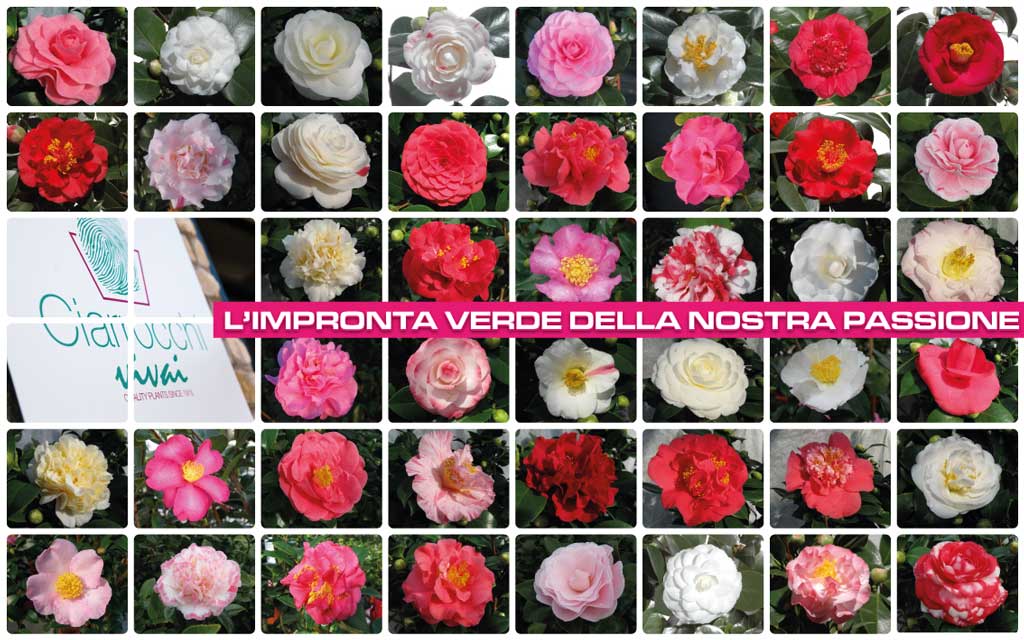Ciarrocchi Nursery Camellias

The Camellia is a genus of flowering plants that belongs to the Theaceae family, native to the tropical areas of Asia. The genus name, chosen by Linnaeus, is derived from the Latinized name of the Jesuit missionary Georg Joseph Kamel (1661-1706), chemist and botanist, who first imported the plant from Japan.

Our preciuos and coloured camellias
The genus Camellia includes plants in shrub or small tree, evergreen, tall up to 15 m. The leaves are simple alternate, green color more or less dark according to species, shiny and leathery, sometimes fleshy and have stipules and aromatic glands, with smooth or crenate margins, elliptical, lanceolate or oblong-lanceolate.
Flowers are single or double, white, pink or red, fragrance free or very fragrant; these are plants adapted to temperate and humid climates.
In tropical areas of Asia, from the Camellia sinensis (L.) O. Kuntze ( = C. thea), and its young leaves is obtained the noted refreshing beverage known as tea.
The most cultivated as an ornamental plant in gardens, parks and boulevards, is the CAMELIA JAPONICA. Originally from Korea and Japan it’s a shrub that reaches a few meters tall; it has evergreen leaves, oval, of a shiny dark green; it has a spring flowering with colourful flowers in various shades from white to deep red, rose-shaped blooms open and flattened.
About winter-flowering camellias, our thoughts immediately go to CAMELIA SASANQUA, a specie native to the Japanese island of Okinawa, where it is called “sazankwa” (which means “mountain tea flower”) and where it has been cultivated for several centuries, also for reasons related to feed. Characterized by rather small and narrow leaves, as well as lightly scented flower-shaped semi-double flowers with rose-coloured or white petals, the species was introduced to Europe in the mid-700. Soon exploited by breeders and nurserymen, both for its hardiness, both for the advantage of its flowering between October and March (depending on the variety), the Camelia Sasanqua has generated hundreds of new forms, often very different between them.

Camellia japonica was introduced into Europe from Japan in its simple form in 1739 while the different varieties with double flowers were imported from China in 1792 and many others in the first two decades of the 1800s. It is thought 23 varieties produced by Japanese and Chinese floriculturists, had been imported from the Far East.
It must be said that the Camellias were very popular in 1800 and that all floriculture was based on their flowers, so that begonias, balsamine, roses, etc were created all in a camellia shape. Until, due to the exaggeration in the creation and research of larger, more double, multi-coloured flowers made become these plants sickening and for this reason they probably passed into oblivion.
The Ciarrocchi Nursery – in the course of its hundred years of activity – has become specialized in the production of the JAPONICA and SASANQUA Camellias. Our camellias are produced with particular attention aesthetics, to meet the requests of demanding customers and experts, which seeks compact but harmonious plants.
Precisely for this reason great attention is given to the selection of plants ready for shipment, in order to guarantee uniform batches corresponding to the required standards.
FEATURES
It’s best to place the Camellia in partial shade and not in direct sunlight and ensure a humid environment and a well-ventilated area.
During the cold season let the soil dry between an irrigation and another . It’s important to ensure a fairly moist environment around the Camellia to foster the development of the gems that would otherwise dry up.
It would be advisable to water using non-calcareous water.
The type of fertilizer to use is a 2 : 0,8 : 1,5 formula: namely 2 parts of Nitrogen (N), 0.8 shares of Phosphorus (P2O5) and 1.5 parts of Potassium ( K2O). It’s important that the nitrogen has a higher title as this promotes the formation of more brilliant green leaves.
The period for repotting is from September to October and it is preferable to do it every year.
NB: Since it is preferable that the scions remain at rest until the time of the grafting, it is good to pick them up during the winter and keep them cool.
Remedy : Remove the leaves of Camelia affected and make treatments with products based on copper . If the plant is small you can remove them with a cotton ball soaked in alcohol but if the plant is large and well developed then it is advisable to use with specific pesticides available at a good nursery.
"If you would be happy for a day: get drunk. If you would be happy for a month: dill a pig. If you want be happy for a year: get married. If you want be happy all your life… grow camellias"
- Old Chinese Proverb

 English
English Italiano
Italiano  Deutsch
Deutsch  Français
Français 

